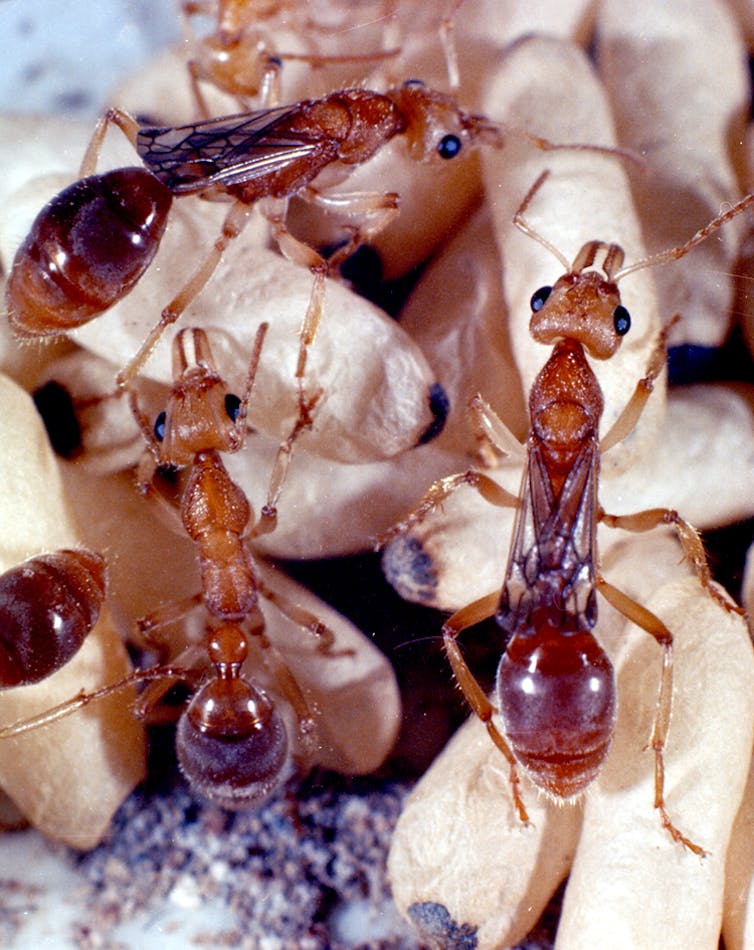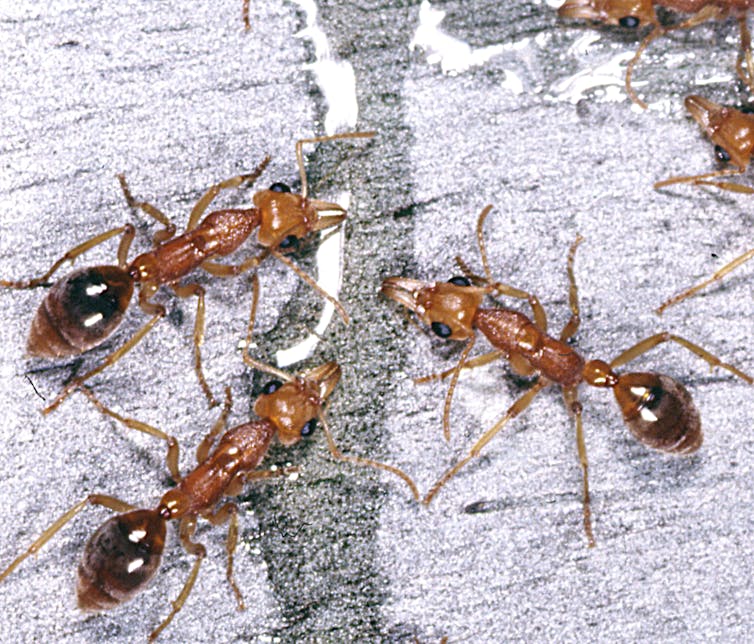The Dinosaur Ant (Nothomyrmecia macrops) is so-called because it is a “living fossil”. It is arguably one of the closest living examples of what some of the earliest true ants might have been like, both in body plan and behaviour, perhaps 100 million years ago.
Ants evolved from wasps, and Nothomyrmecia is thought to be the most wasp-like of all ant species alive today. It is related to Australian endemic bulldog ants (of the genus Myrmecia), but is more primitive. It is therefore a prime subject for studying the evolution of ants and their social behaviour.
Dinosaur Ants live in colonies like other ants. Each night worker foragers leave the nests to seek liquid or soluble food, and to hunt for prey insects, which are captured, immobilised by stinging and promptly returned to the nests as food for the carnivorous larvae.
All prospective foragers leave the nest entrances during a short period at dusk. Each crosses the ground to a host tree where it usually remains the whole night searching for prey. The ants hunt individually, and there is no evidence of mutual cooperation in this or any other task (including brood-care activities within the nests), unlike other species of ants.
If a huntress secures prey she returns promptly to the nest, carrying the booty in her jaws. Unsuccessful foragers remain in the foliage until dawn, when all descend from the host trees and cross the ground to their nests - they are programmed individually to arrive home during a brief period of around 20 to 30 minutes.
Status
The Dinosaur Ant was first collected in 1931, at the West Australian end of the Great Australian Bight near Mt Ragged. The two original worker specimens were sent to the Museum of Victoria, and were the only known examples until 1977. Then, an Australian National Insect Collection expedition (in fact en route from Canberra to far-away Mt Ragged) unexpectedly discovered a thriving population 1,200 km to the east, at an unscheduled overnight stop near Poochera, South Australia.
Before the Poochera rediscovery a number of failed Australian and international expeditions and collectors had combed the original West Australian source area attempting to secure living individuals and colonies for research studies. The Dinosaur Ant had by now become the Holy Grail of Myrmecology (the study of ants).
Since 1990 populations have been found at further sites in the eastern Bight area, and from north-central Eyre Peninsula. Nothomyrmecia has never been rediscovered in WA. This significant, iconic insect has now been subject to much research involving some of the world’s most prominent myrmecologists.

Threats
Because they forage in trees, one of the greatest threats to Dinosaur Ants is bushfires. Canopy fires at night would not only reduce food resources, but up to 50% of worker ants could be lost, leaving their colonies in crisis.
Dinosaur Ants must have historically experienced and recovered from these sorts of fires, but more frequent, wide-ranging and more destructive fires could tip the balance of survival.
Climate change is also a direct threat to the survival of Dinosaur Ants, thanks to a unique dependence on cold temperatures for the ants to forage. Dinosaur Ants won’t leave their nest at night if temperatures at dusk are warmer than 5C. In fact the cold-adapted foraging ants have been observed returning to nests at dawn with temperatures as low as -1C.
A rise in night temperatures by a few degrees could gravely reduce suitable habitat for Nothomyrmecia, by preventing foraging behaviour. Known populations experience cool temperatures thanks to cold winds blowing off the cold Southern Ocean at night, so increases in sea temperatures would be bad news for the ants.
One research expedition tracked the ants during a nine-day heatwave at Poochera. During the whole period, only two Dinosaur Ants were found away from their nests. Normally there would be hundreds.
But why does Nothomyrmecia prefer the cold? One theory is that waiting for cold temperatures at night is an adaptation to avoid competition for food and attacks from other ants that forage during the day. Some diurnal ant species (such as Iridomyrmex) stay active during warm nights, but return to the nest earlier on cold nights. They have been shown to vigorously attack and kill any Dinosaur Ants they encounter.
Also, prey species are easier are more easily caught at low temperatures, when they enter torpor.
Strategy
The major strategy for survival of Nothomyrmecia is action against climate change on behalf of all the world’s animals and plants.
Conclusion
It has been said in jest that if Australia was to drift further north the Dinsoaur Ant would fall off the bottom of the continent. Climate change could eventually accomplish much the same thing, a catastrophe for this biological national treasure.


